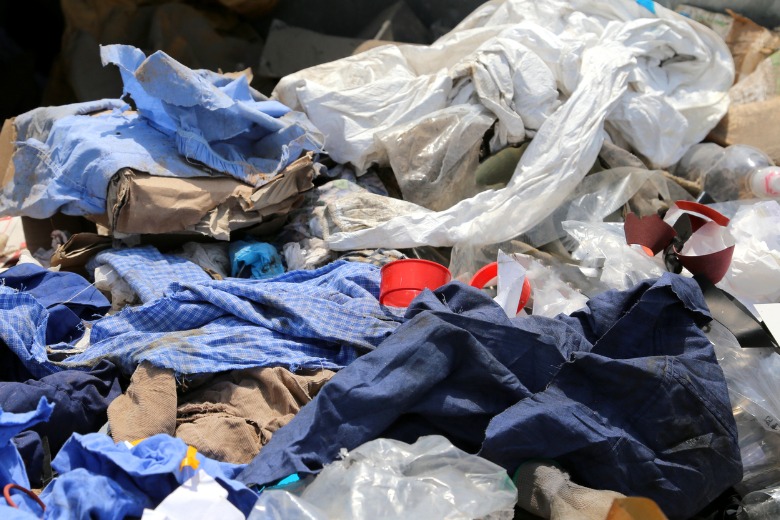
Local government authorities are partnering with a textile recovery operator to tackle a growing waste problem, writes Adrian Jones.

Discarded swimmers and microfiber polyester towels are just as much of an environmental hazard as plastic bottles are. But only one of them gets treated seriously.
The situation came into focus during the clean-up after the recent Australia Day surf carnival at Sydney’s Manly beach.
As volunteers combed the sands for litter, much care was taken to pick up plastic bottles, which were dispatched into a bag bound for recycling.
Yet stray swimmers and towels were dropped straight into the rubbish.
It was a stark reminder of how far we still have to go to educate people about the growing problem of waste textiles – as well as the opportunities for local government to take a leading role in tackling it.
Sidelined from the sustainability narrative
In terms of recycling and reprocessing, the high profile of paper, plastics, batteries and even paint have shaped a sustainability narrative that enjoys widespread community buy-in and significant action, up to and including government legislation.
Yet similar sentiments and strategies don’t extend to textile waste. This is despite the fact Australia produces up to 1 million tonnes of textile waste per annum – including our own clothes, uniforms and bed linens. At least 60-70 per cent of that is suitable for recycling – but it’s going begging.
So where is it going? Into general rubbish and landfill, for the most part.
The Textile Plan for Sydney Councils suggests 5.05 per cent of Sydney’s kerbside residual waste stream is textiles, but adds that auditing in some councils has shown textiles to comprise up to 6 per cent (City of Sydney) and even 11 per cent (Lane Cove Council).
The figure highlights the need for local government to take a leadership role.
When it comes to textiles, there’s a systematic lack of visibility, guidance and education. With plastics for example, we’ve all seen pictures of turtles eating plastic bags or overseas beaches choked with plastic bottles. There’s a visual driver around the importance of recycling these items. There’s also an inherent awareness that plastic isn’t natural.
Even though our clothing is made of polyester- often blended so it’s around 55-60 per cent plastic – and requires a significant amount of energy to create, we simply don’t view it the same way.
Challenges and opportunities
But while dealing with textile waste is an ever-growing challenge, it can also present an opportunity.
Last year, four Australian councils – Noosa (Qld), Ku-ring-gai (NSW), and Bendigo and Brimbank (Vic) – partnered with Australian company BlockTexx to in an initiative encouraging residents to part ways with old bedlinen, towels and other clothing that had been sitting in cupboards earmarked for landfill.
The amounts collected suggest could be 100,000 tonnes of bedlinen, sitting in cupboards and going to waste Australia-wide.
So far, the program has collected over 20 tonnes of textiles, which were then reprocessed into raw materials and resources for manufacturing, construction, and agriculture.
The initiative not only saved landfill costs, but educated ratepayers that there are onshore alternatives to burying or burning textile waste.
The repurposed material can also be returned to councils in the form of witches’ hats, safety barriers, fertiliser, even children’s playground equipment, which means local government can play a lead role in driving demand for recyclate material.
Textile waste a growing problem
Global textile waste is expected to reach 140 million tonnes by 2030, according to a 2017 report by the not-for-profit Global Fashion Agenda.
Bocktexx estimates the average household has between 8-10kg of excess bedlinen.
In a council area of 10,000 households, that represents 5000 donations of up to 10kg, meaning 50 tonnes of linen diverted from landfill.
For local government bodies that may not yet have developed a strategy or vision for dealing with textile waste, the reasons to do so are myriad and imperative. They include:
- Textiles are a major waste stream. And they’re not going away. Recycled, they are a valuable resource that local communities can benefit from
- When it comes to provenance, residents are increasingly looking not just to the origins of their textiles but also their potential for a second, third, fourth and beyond life.
- Diverting product from landfill results in operational and environmental savings.
- Textile reuse feeds into a circular economy, with waste repurposed into raw materials that can be used in other Australian industries, creating associated employment opportunities.
- The efficacy of collection activities can also be improved. With curbside clean-ups, for example, the addition of textiles could be structured such that charities take the wearables and private enterprise takes the rest for reprocessing, slashing the amount of ‘lost’ material.
Ultimately, people understand there is a price to pay for consumption. And they’re looking for vision and leadership to focus on lowering that cost – not just financial but also environmental and beyond.
It’s an urgent opportunity for local government, and one that the experts and innovators in the private sector are primed to help with.
Adrian Jones is co-founder of BlockTexx.
Comment below to have your say on this story.
If you have a news story or tip-off, get in touch at editorial@governmentnews.com.au.
Sign up to the Government News newsletter